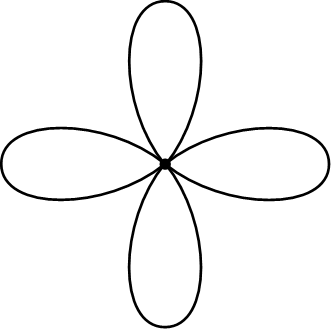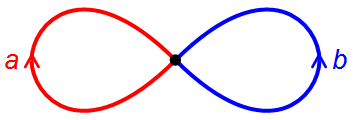This article was published in Scientific American’s former blog network and reflects the views of the author, not necessarily those of Scientific American
The bouquet of n circles has a special place in my heart. I guess I should say the bouquets of n circles have a special place in my heart because for every whole number n, there is such a bouquet. Also called a wedge of n circles or a rose with n petals (even though it usually looks more like a daisy), this space consists of n circles that all meet at one point. We think about this space topologically, where exact shapes and distances don’t really matter, so usually in pictures, the “circles” are deformed a bit. Otherwise they would overlap when we tried to draw them in a plane.

A bouquet of 4 circles. Credit: Jim Belk Wikimedia
The reason I love this space so much is that it’s an example of topology yielding an insight into algebra. Algebra, which is basically the study of symmetry and structure, is an incredibly useful tool in topology, but its a little more rare for topology to be applicable in algebra. To see why, we need to visit the fundamental group.
On supporting science journalism
If you're enjoying this article, consider supporting our award-winning journalism by subscribing. By purchasing a subscription you are helping to ensure the future of impactful stories about the discoveries and ideas shaping our world today.
The fundamental group is, well, a fundamentally important tool topologists use to distinguish and describe spaces. The fundamental group describes the kinds of loops you can draw in a space. Two loops are considered the same if you can wiggle one of them around to the other one while remaining in the space. Any two loops in a disc or plane are equivalent in this way, so their fundamental groups are very boring. But in a space like a torus (the surface of a donut), there are loops that can’t be wiggled around into each other, and the fundamental group has a little more going on.
In a bouquet of n circles, loops can be identified by what circles they travel around, in what direction, how many times, and in what order. For example, in a bouquet of 2 circles, or figure 8, there is a loop that goes clockwise around the left circle once and then the right circle. This loop isn’t the same as a loop that goes around the right circle and then the left circle because there’s no room in the space for you to manipulate one loop and turn it into the other. (You can use rubber bands to convince yourself of this fact.) In the picture below, the loop that goes clockwise around the left circle is labeled a, the loop that goes counterclockwise around the right circle is labeled b, and we define a-1(pronounced “a inverse”) to be the loop that goes counterclockwise around the left circle and b-1 to be the loop that goes clockwise around the right circle.

A figure 8, or the bouquet of 2 circles. Credit: Jim Belk Wikimedia
The fundamental group of the figure 8 can be represented by all finite strings of a, a-1, b, and b-1. (You should be a little suspicious I snuck “finite” in there because I never told you the rigorous definition of a loop requires it to have a finite length. Now I have.) If you get an a next to a-1 or b next to b-1, you can cancel them out.
The fancy way to describe the fundamental group of the figure 8 is the free group on 2 generators. The generators are the letters a and b, which automatically come with their inverses, and the word free refers to the fact that, other than putting a letter next to its inverse, there’s no way to cancel out any sets of letters that appear next to each other. There are groups in which these cancellations can occur, but a free group isn't the place for that.
Just as the fundamental group of a figure 8 is a free group on two generators, the fundamental group of a bouquet of n circles is a free group with n generators. It seems pretty pedestrian until you get to use these bouquets to prove a really cool and, to me at least, counterintuitive fact about free groups: the free group on 3 generators is a subgroup of the free group on 2 generators! More generally, the free group on n generators is a subgroup of the free group on 2 generators. That’s counterintuitive to me because it sure seems like 3 generators should give you a “bigger” group than 2 generators would, and subgroups seem “smaller” than the groups they are subgroups of. But these intuitive notions often go out the window when it comes to infinite things like free groups.
Sorry, topology students, I’m not going to tell you how to use bouquets of circles to show that the free group on 3 generators is a subgroup of the free group on 2 generators. But it’s a very cool example of a proof of a fact in algebra practically falling out of a topological setting once you have the right theorems in place. (Those theorems do a lot of heavy lifting to connect algebra and topology, so it’s not like it’s coming out of nowhere, but I think it’s still pretty cool.)
I struggled to get through the topology qualifying exam in graduate school. (Quals or prelims are the exams most graduate programs require students to pass before they officially move on to the research and dissertation portion of the degree. Usually students are expected to pass in the first year or two of their graduate program.) Because of that struggle and the extra time and effort I spent with that material, it’s probably the only qual I could still pass today! One of the last things I studied the night before the exam was a section at the very end of the textbook about free groups and bouquets of n circles. I think we had covered the material in class, but it hadn’t stuck then. It was probably my nth time reading the section and trying to understand it for a fairly large n, but this time was different. I don’t think the heavens actually opened up, but I do remember that click and the lightness I felt when I finally really understood the big ideas in the section. The next morning, the exam happened to have two questions about the material I had just studied. I felt very lucky to have studied just the right thing before I closed my book for the night, and I’ve been grateful to bouquets of circles ever since.
Read about more of my favorite spaces: The Cantor Set Fat Cantor Sets The Topologist’s Sine Curve Cantor's Leaky Tent The Infinite Earring The Line with Two Origins The House with Two Rooms The Fano Plane The Torus The Three-Torus The Möbius Strip The Long Line Space-Filling Curves The Wallis Sieve Two Tori Glued along a Slit The Empty Set The Menger Sponge The Connected Sum of Four Hopf Links Borromean Rings The Sierpinski Triangle Lexicographic Ordering on the Unit Square The SNCF Metric The Mandelbrot Set Fatou's Pancake The Pseudosphere The Douady Rabbit The Poincaré Homology Sphere The Kovalevskaya Top A 6-Holed Torus The Real Projective Plane The 1-Dimensional Sphere The Loch Ness Monster The Koch Snowflake The Bicylinder The Catenoid SO(3) The pseudo-rhombicuboctahedron The Moser spindle The Witch of Agnesi Antoine's Necklace